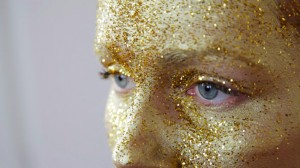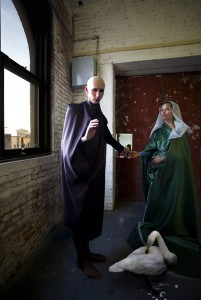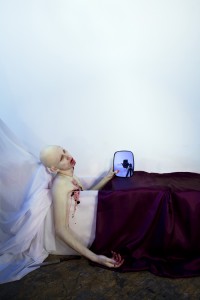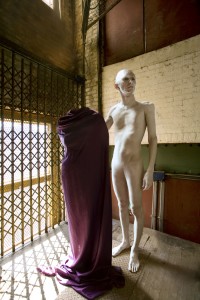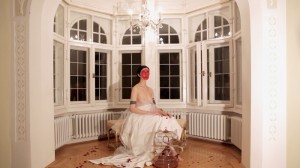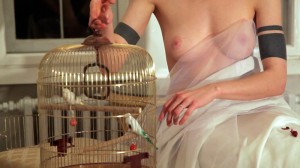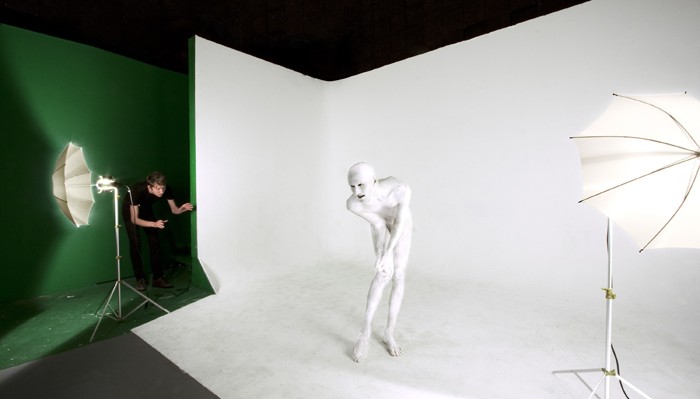
6.18.13 Interview with Dean Dempsey at his studio on Orchard Street, New York City by Lisa A. Banner
Lisa A. Banner: Dean, you have a unique aesthetic language that you explore through photographs in series, and in installations. At times you carefully construct tableaus, and take a photograph, sometimes showing the artifice and sometimes not, often using yourself as subject or object in a tableau. But recently, you have been branching into other forms, like drawing, and video projections, or film, adding performance to what was more photography-based work. Are there certain artists or perspectives that you can cite as influences on your creative process?
Dean Dempsey: Lately I’ve been into David Noonan, who does these photo collages that are painterly and feel like burlesque sideshow runways. And masks. I love this stuff—performative, outsider art.
But I also like the show that’s up now at Invisible Exports (NYC) on the Lower East Side.
No one knows his real name, so they call him the Philadelphia Wire Man. They are just little wire sculptures. Bundled. The work is interesting in its own way. He’s completely unknown, but about a thousand of these sculptures were found in the garbage in Philadelphia in the 1970s.
LAB: An anonymous and unknown person you meet on the street can be as much an influence on our psyche as someone famous, and this invisible man clearly made a big impression on you.
DD: I’m always interested in the artists who have an audience of One. That is, themselves. How many artists don’t really make it to the stage, so they only perform for themselves.
LAB: Looking in the mirror. They are like talking heads.
DD: Yeah, Talking Heads! Speaking of David Byrne, since we’re wearing all white, it reminds me of him. He gave a lecture where he said that about ninety-eight percent of the people in the room were going to fail as artists. Whereas I think he, David Byrne, is a totally different story.
LAB: That was this June, at Columbia School of the Arts (June 10, 2013, Commencement Speech). He started with a list: First, “Never use a typeface less than 8.” Last, the man in fur pajamas talked about airbrushing the hair off of people’s arms. But the second point on his list was, “Money changes everything.” He was lucky that his music financed his art.
DD: It’s a ridiculous lifestyle and ambition. But I like it! Like Marc Straus said during the opening of his recent Jeff Wall show, with Thomas Bangsted, “You have to be crazy to be in this business.”
LAB: But we love it.
DD: Yeah, but think about the Armory show and the expense of the booths, and all that. But…back to the question. With some of the art historical references, I am influenced by a good story and a pretty picture. Like Jan Van Eyck’s “Arnolfini Marriage,” and David’s “Death of Marat,” and Caravaggio’s paintings, fantastic, rich, opulent work with a whole lineage of narrative stories behind them, which I think is interesting. A lot of them have religious connotations, too. Any time when I was a kid, I would go into a cathedral or a church or a mosque or a temple just to see it- to see where the fear of death and the hope of the afterlife intersect.
LAB: Very poetic. That poetry comes through in your work, especially in that series using paintings as a springboard for your own interpretation, and expanding upon those intersections where the artist appears in some form as a reflection of the scene, or as a voyeur who appears in a mirror. You write about exploring “the historical references and constructed futures” expressed in your work. The historical references run the gamut from Jan Van Eyck, to Bruce Nauman, to your own personal trajectory.
DD: The intersection of fear and hope are part of some of the series. But that also comes through in the concept of “In the Dark,” and I want to expand upon that. It reveals the intersection of hope and fear, artifice and art.
LAB: Well put. “In the Dark” is your video projection, which flashes on and off, and at first looks like a moving map of the United States. Rather than immediately seeing the Nauman reference, it almost appears to be a map gone wild, with pieces coming together and turning, twisting, remaking themselves into another configuration. At first you look and see one thing, and keep looking at something flickering and moving, and don’t really see what it is until you see something clearly, and then you can’t see anything else.
DD: Yeah.
LAB: “In the Dark” plays with time, in addition to bringing parallel narratives to life in moving shapes and evocative gestures, giving us 15 minutes to realize what our own relationship is to “collective fear, desire, fantasy.”
DD: Yeah, thinking of anatomy as a form of geography is interesting in itself. It does look like some otherworldly topography; puzzle pieces. When I first showed that piece, it was a projection, and larger than life, so that made it more ambiguous, and hard to decipher as to its meaning and what it is, essentially, is a blowjob. It becomes kind of cartoonish.
[LAUGHS]
I saw it in the context of the Caravaggio and historical reference pieces. There wasn’t any conscious connection or relationship between them, the projection and the photo tableaus. They were just what I was showing and producing at that time. The historical reference was something that I was into at the time and now I’ve just decided to do something different. But the reason I chose Caravaggio’s “Tooth Puller,” David’s “Death of Marat,” and the Jan Van Eyck, was that I liked the pictures. I liked the pictures so I started to read about them, and the details, like the mirror in the Arnolfini portrait, with the painter reflected. So I used that mirror idea again in “Berries.”
LAB: You showed your artifice- the presence of the artist at work. When you reference historical paintings, there is a completely new language that you use, adding figures, changing poses, playing with the idea of the mirror and the camera being the same. Can you comment on that idea of the reflection and the reflected image?
DD: My whole interest in artifice came from a piece I did called “The Director,” a commission from a collector to do a self-portrait. I had never done a self-portrait, not consciously. So I used myself as subject and as Director. In that image you see the lights and then the Director directing the subject, plus the green screen exaggerating the ideas of artifice. So I just took the idea and used it again with “Swan” and “Berries.”
LAB: Your work reflects some influences from photographers who create tableaus and constructed realities, like Cindy Sherman. Are they conscious influences for you? Like Sherman, many times, you feature yourself as model in the constructed, glistening clean and stark tableaus that relate to family, or the elaborate constructed interpretations that relate to historical paintings. But in your recent film that will debut at BOSI gallery in October, you are using models instead- playing with the idea of the mannequin, or the pose of a fashion photo shoot. I’d like to hear about your use of models in the film, as opposed to using yourself as the subject and model as before.
DD: It was kind of a segue, to move from recognizable images of me, they went to muted, hairless alien androgynous figures, to some sort of gray area, and then they went to mass characters. The last picture I made of myself was “Bound,” with the red connecting the heads, completely removing my face from the work. Now I’m not using myself at all.
LAB: There’s elegance in that progression.
DD: One of the reasons I started using myself was that it was convenient; I was always available and I could control my posture and expressions. And it was an experiment of creating images, layering exposures into one. Part of New York is that there are characters everywhere. And photography for me began as a study for film. I wish that I could make a movie like a Steve Buscemi movie,”Trees Lounge,” and sometimes I wish some of my work wasn’t so conceptually driven. There are so many different characters with bizarre stories and they all look differently, and there is a uniqueness in seeing what other people can do. It is also another exercise of control.
LAB: How so?
DD: It is more of a challenge to work with other people. It is an exercise in control, not an execution of control. People get bored of the same image. That’s another thing! I constantly ask myself, “What will the viewer think?” It is the common denominator in human experience, not only in the art world, to seek approval from others. Will they like it?
If I was making art for myself, I would be the Philadelphia Wire Man, and be completely obscure, or I would just keep a diary. But I don’t want to do that. The composite and the concept becomes a distraction to the execution. And that doesn’t interest me at all. I’m tired of having to answer to Cindy Sherman, because I was making that kind of work before, but it isn’t something that has influenced me consciously. I do like the costuming and stuff, and I like her most recent work, the society portraits.
But I am tired of having to answer to her and other artists who use themselves in their work. Right now I like sitting in the director’s chair and turning the camera away from myself for a change.
But I guess an artist like Matthew Barney has put himself in his own work while also sitting in the director’s chair, so I guess it depends. Steve Buscemi, too, for that matter, who I mentioned earlier. A lot of people have straddled both worlds.
The point is that I’m using exclusively other people in the film. One day, maybe with more funding, I would like to play a cameo in one of my own films. But for now, I’m happy working with new characters.
LAB: You completed the film in Munich, using art students as models, right?
DD: The film with the balloons I did in Munich last year, during the Villa Waldberta residency that I was invited to. I was staying in this gingerbread mansion and it had ornate interiors to it, and I wanted to do something specific to that space. So I shot that film. Those are girls that I found by hanging out at the art academy. I just approached people who might be good for the film.
LAB: Does the film have a plot? Do you think of it that way?
DD: Yeah, the original idea was kind of an investigation of children’s rhymes and history, but it devolved into something different. I like the balloons.
LAB: Black and white balloons, falling and rising. Do the balloons have a specific meaning, depending upon their color?
DD: To me, the black balloons are descending and lying upon the ground so they’re not floating the way the white balloons are suspended in the air.
I read somewhere that in dreams they denote despair and death, depending upon whether they are ascending or descending. Declining hopes, as they fall. And if they pop, they are goals that are not met.
In this film, the model is rolling these balloons along the floor and one by one, popping the black balloons and replacing them with the white ones in the air, suggesting optimism. It was a sort of choreography. We see her on the ground, and then placing them into a constellation of white balloons with a gold one, and then she has a gold face.
The model in the film has a daughter, so the way she was with the balloons was sort of maternal. She treated them with a maternal instinct, caressing them, holding them, which was exciting because she didn’t need much direction. I just let her go with it.
LAB: There is another model with a red painted face.
DD: Yeah. In the other one, I liked the red face, and she just sort of sat there, after having her face painted by someone, and being read a lullaby that would have made sense in the original concept of the film, to use children’s lullabies as a soundtrack, or an undertone of melody to the moral hysteria of the fifteenth- and sixteenth-century witch hunts in Germany. I wanted to do something specific to Bavaria since I was in Munich. So there is an underlying feeling of the mass panic about what’s not understood.
The stories are horrible. Like the story of an eleven-year-old boy who was wandering around and didn’t know where he was, so they burned him.
And another girl who was too pretty, so they burned her.
I wanted to work with a pre-school to get the kids to wear Halloween costumes and they would run around and sing the lullabies, but I couldn’t get the kids, so I let the idea become something else. It evolved into this.
I think it has to be two different films, shown on two different monitors. “Good Evening, Good Night”- that’s the name of the lullaby- but the title of the film now is “Dream Sequence.”
Thinking strategically for BOSI gallery, they have two projectors so I might split the film into two pieces. But it could be the same film as a diptych. Two that work together, but they have to be apart.
Right now I’m trying to learn film-editing software.
LAB: What else are you working on now?
DD: Some installations. I’ll have an installation of white birds in white cages in the center of the gallery for the show. So that will be the sound for the video. I will have the cages suspended, and then a line of white bulbs maybe.
On Friday I’m shooting a new film with the girl who was in that group of drawings you saw, “Second Nature.”
I want to do something with hands. Like one of those finger games that you make in school with origami. I might use that in the film, and then make her into twins by compositing her twice….And maybe a circle of candles can be there, since the room is sort of dark. I like the David Noonan masks, so I might also use something inspired by that.
I might also play with the idea of the subconscious. The good angel, and the bad angel, one whispering in your ear, “What’s another scoop gonna do? Sugar’s good,” and then the other one says, “Have more salad.” One says, “Don’t do cocaine,” and the other one says, “But what the hell, have some more.”
[LAUGHS]
The girls might be in white or black or red. And you just have to see what happens with this loose idea. It may become something else. She’s really bizarre, so fun to work with.
LAB: You have had a lot of honors, and now you have one piece in the Crocker Museum in California.
DD: “Wrong Bar”—I took it off my website—it is a multiple self-composite and it is lined up alongside a bar, and everyone has turned to look at who has walked in, but the person is omitted from the frame.
It’s like when you walk into the wrong bar and the music stops and everyone stops talking- I was trying to recreate that scene.
I used to have fun with it, but I’m not having fun sitting in front of the computer any more. So I’m doing something different.
Now I’m making big paintings. And it’s just me and the material, or the sawdust, when I’m making the frames. It’s a good feeling—just to be me with the materials, instead of editing and staring at the computer for hours.
LAB: You sound really motivated about this new phase.
DD: I’m excited and about to show all this new stuff. A total 180. The films and the photos show a lineage. And I hope people will see that in this new show. The paintings are out of the blue.
LAB: Can you describe them?
DD: Iridescent, black gradient enamel paintings. Some gold ones. I use a lot of glitter, glossy black and matte black, and I’m using iridescent glitter, so it shimmers like a butterfly wing. Really, I just want to make pretty things.
I like making new work and prototypes. Failures with glimmers of hope.
[LAUGHS]
Glimmers of something better to come out of it. All of this from a new medium. Never worked with glitter and paint. Just trial and error, so it’s a big change.
LAB: Your work has changed so much over the last four years. What have been the most important reasons for the evolution? Does being in NYC have anything to do with it?
DD: Yeah. Everything. I want to keep the work simple but also very dynamic.
LAB: You’ve also shown a lot of work abroad, in Italy and Germany.
DD: I had a solo show last May and then a residency in October-November, so last year was a good year, though much too short. Then I went to Istanbul. That was an amazing experience. It comes back to me in my dreams, and I remember the smell of it, the street food, the ocean, and the stray cats. I felt very far from home and that was a good feeling.
LAB: Dreams are wonderful. Was this the first time you’d been to these places?
DD: Yes, I’d been to Berlin, but not to the other places. I had never been to Istanbul, but I can’t wait to go back.
LAB: Wishes, hopes, and desires. That’s a good place to finish this encounter, and this interview. Looking forward to Dream Sequences.
DD: Me, too!
Dean Dempsey’s photo works have been exhibited in national and international venues in North America, Europe and Asia, including the Crocker Art Museum, Aperture Gallery, ArtPadSF and Museum of the Americas in Washington, D.C. He is in the permanent collections of several institutions, including the Kinsey Institute, En Foco, and the Crocker Art Museum.
Dean Dempsey is represented by BOSI Contemporary in New York City and will present his first solo exhibition opening this Thursday, October 10, 6-8pm. The exhibition is presented in collaboration with Creem Magazine. A catalogue accompanying the exhibition will be available for sale at the gallery or can be order at Lulu.
Tags: Journal